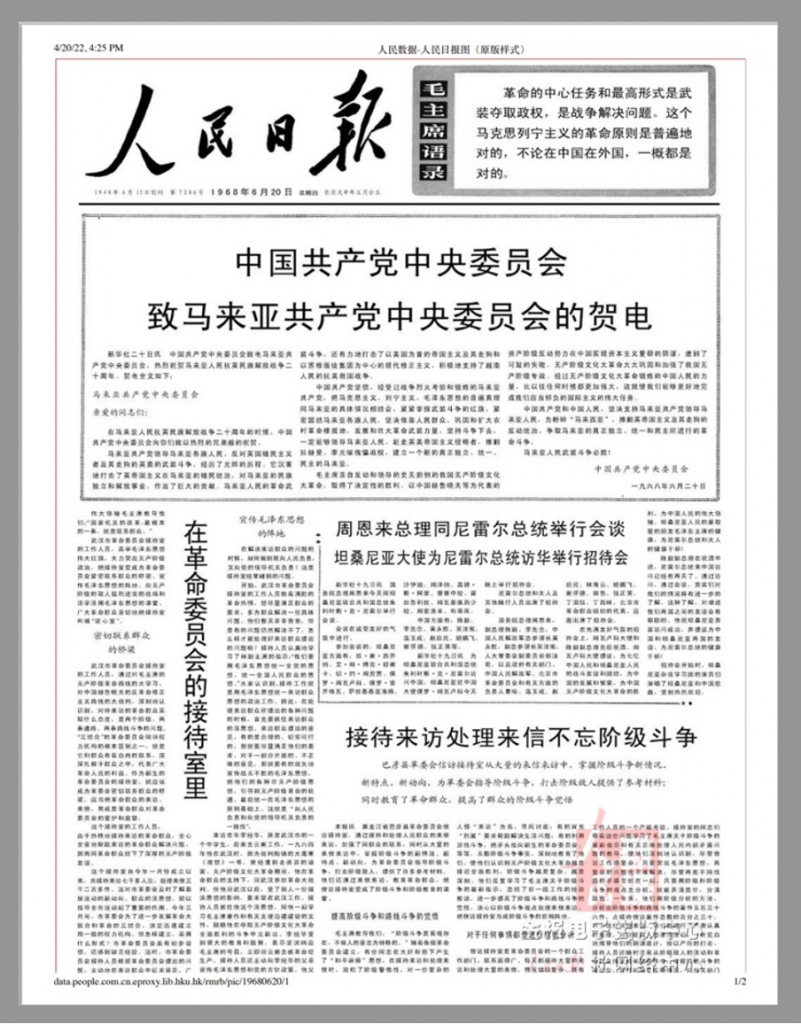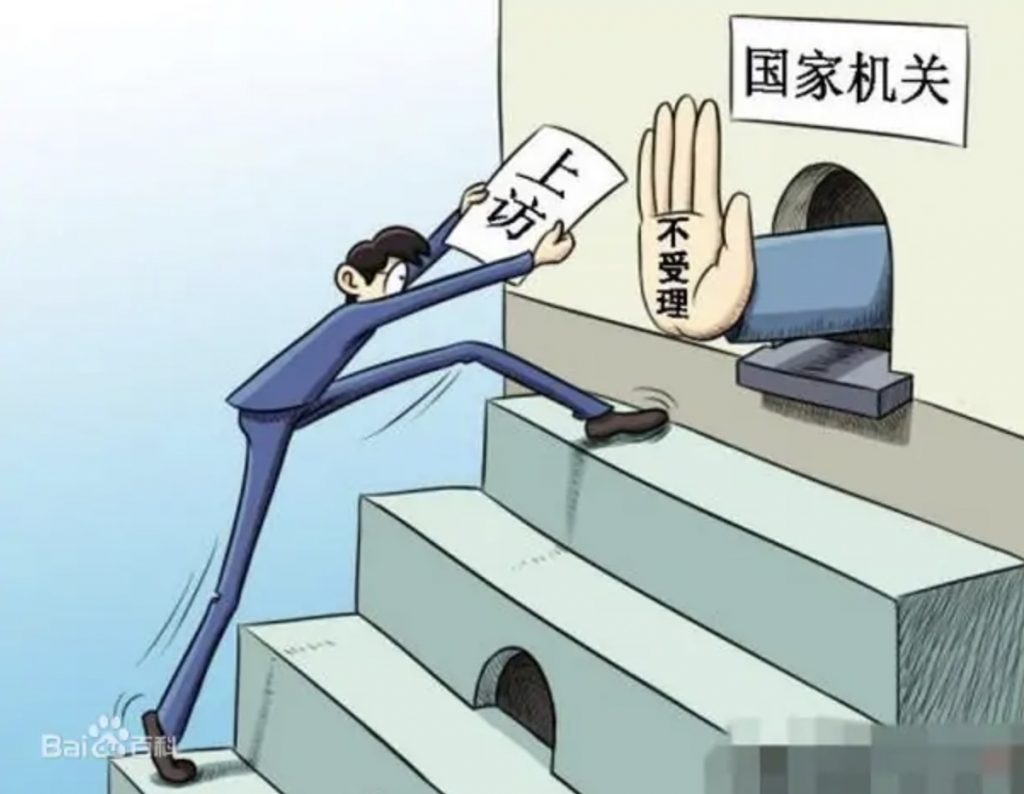Court sitting during Qing Dynasty in 1899. Public domain image available at Wikimedia Commons.
China’s petitioning system has its roots in more ancient practices of hearing and airing grievances going back perhaps even as far as the Western Zhou dynasty (1047-772 B.C.), when common people could stand on a “lung stone” (肺石) to “report a grievance to the higher authorities.” Sources on the history of “petitioning” in the People’s Republic of China often trace the practice to the establishment in early 1950, within months of the founding of the “New China,” of the Secretariat Office of the CCP Central Committee General Office (中共中央办公厅秘书室), which “specialized in handling letters from the public to Chairman Mao Zedong and other leaders of the Central Government.”
The first report in the People’s Daily to mention the office came in September 1951, noting that the office had responded on Mao Zedong’s behalf to a letter from 161 families of “martyred army workers” from the city of Suzhou. The letter from Suzhou was in fact a thank-you letter, according to the report, the families expressing their gratitude for Mao’s “warm care.” The first mention of the office, therefore, is not about its complaints resolution role per se, but rather about its role as the mailbox for the central Party leadership, charged with interaction with the masses.
A People’s Daily report in 1955 mentions another letter written by the office to students doing self-study in Shanghai. The letter is quoted as saying: “The letter you wrote to Chairman Mao has been received. It is very good that you have worked hard in self-education, actively participating in work in society, improving your political and cultural level, and strengthening your views of labor. It is hoped that you will continue to work hard and prepare yourselves for future work and production.”

There is evidence in the press record, however, that petition letters were reaching central authorities at the provincial level as a form of oversight from the early 1950s up to around the time of the Anti-Rightist Movement in 1957. One People’s Daily report published on Christmas Day in 1952 said a critical letter received from Shandong province, apparently expressing concern that “certain county and district cadres are seriously suppressing criticism from the masses,” had been forwarded to “relevant departments” for proper handling. This report in the newspaper was signed by the “Secretariat Office of the Shandong Branch of the Central Committee of the CCP” (中共中央山东分局办公厅秘书室).
A report published on May 12, 1957, just weeks before the Anti-Rightist Movement kicked off in earnest, notes that according to an investigation into the matter, “there are more than 50 central-level organs that have accepted visits from the people.” More than 300 cadres were engaged in such work, according to the report, and tens of thousands of visits had been made in 1956. Interestingly, the report notes that “according to the statistics of the General Office of the Central Committee of the CCP, the largest number of requests were for help in resolving difficulties in employment and life, accounting for between 55 and 60 percent of the total, and most other problems dealt with matters of profession and life issues.”
The Cultural Revolution
The earliest actual mention of xinfang as a system in the CCP’s official People’s Daily newspaper dates back to April 26, 1967, by which time the country was already in the throes of the Cultural Revolution. The similar term shangfang (上访), meaning “to petition,” also first appears in the paper in 1967. The letters system was at this point clearly less a mechanism for resolving complaints people had about justice and fair treatment and more about the conduct of “class struggle” (阶级斗争). A page-one article on June 20, 1968, warned officials in petitioning offices against “relaxing their class alertness” in addressing letters and visits. Some “class enemies,” the article said, used the system as a pretext for “demanding details.”

Reform and Opening
As China’s reform and opening policy took hold in the late 1970s, the country’s petitioning system received an overhaul. This began in 1977 with the formation of the Bureau of Letters and Calls under the General Office of the CCP (中央办公厅信访局), followed in 1980 by the establishment of the Bureau of Letters and Calls of the General Office of the State Council (国务院办公厅信访局). These offices were merged in 1986, and further reforms in 2000 resulted eventually in the creation of the National Bureau of Letters and Calls (国家信访局), which around 2016 was renamed in English the National Public Complaints and Proposals Administration.
The xinfang system extends down from the national to local jurisdictions, including provincial, city and county-level offices. In Guangdong province, for example, there is a provincial-level letters and calls office. In the capital city of Guangzhou, there is also an office, and in each district, such as Panyu, similar offices have been established, which generally also have online complaints mechanisms. The same goes for the countryside, with offices at the county and township levels, and all the way down in many cases to the village level.
In recent years, petitioning has remained the primary tool people in China use to seek justice from the government. Petitions can take a variety of forms, including phone calls, letters, online complaints or in-person visits. Generally, citizens who seek recourse for a perceived injustice – for example, the planned demolition of their home by local authorities – must first report complaints to the government authorities at the closest administrative level. Ultimately, however, a large number of petitioners choose to report to higher authorities, including the central government, as there is a deeply ingrained belief in the relative goodness of the central government as opposed to local authorities. These ideas are related to ideas surrounding the historical figure of Bao Zheng (包拯), also known as Bao Gong (包公), a Chinese politician from the Song Dynasty who was renowned for his great integrity, and who even was reputed to have sentenced his own uncle – throwing off the temptations of nepotism and self-interest. Bao is given the fond title “Justice Bao,” or baoqingtian (包青天).
With courts perceived to be controlled in most cases by local officials, petitioning remains the main channel for citizens with grievances to seek recourse against injustices.
But while petitioners in this multi-layered system are in theory permitted – if they feel like their case was not properly resolved – to report their complaints above the administrative level where they originally lodged a complaint, this can in practice be costly and futile. Petitioners traveling to Beijing to seek recourse are often intercepted, even before they can leave a local county or province, by security thugs deployed by local authorities. In many cases, this cat and mouse game harries petitioners all the way to the capital. Their sufferings, and the failings of the system, were documented by Human Rights Watch in a report in 2005.
Petitioning Today
According to government sources, there were an estimated 890 thousand complaints received across the country in 2021. Citizens generally petition on such issues as household registration, illegal construction, unequal access to education, forced demolition, violent urban management policies, and issues of housing.
In April 2022, The Central Committee of the CCP and the State Council issued Regulation on Complaints and Letters (信访工作条例) which aims to strengthen the institutional mechanisms, responsibilities and tasks, handling procedures, and supervision system for petitioning work.
One goal of the revised regulation was to do away with “duplicate petitions” (重复信访), those in other words that were received within the system more than once, resulting in inefficiencies. Another problem the changes sought to address was so-called “cross-level petitioning” (越级上访), referring to petitions submitted not to the petitioner’s immediate administrative level in their place of residence, or the place where the alleged rights infringement occurred, but rather at a higher level.

But while the government may be able to reduce the number of petitioning cases accepted, and to cut down on “cross-level petitioning,” this does not necessarily translate to greater efficiency for citizens in the handling of complaints to the government. The push to reduce petitions at higher levels could mean that petitions are rejected at lower levels because they directly impact vested interests.
Additional research by David Bandurski.

Stella Chen
The CMP Dictionary
C
D
F
G
M
N
P
S
- Scaling the Wall
- Science
- Second-Generation Reds
- Security
- Seeking Progress in Stability
- Self-Revolution
- Seven Bottom Lines
- Six Adheres
- Smart Governance
- Sneaky Visit
- So-Called
- Socialite
- Soft Resistance
- Soul and Root
- Soundless Saturation / Quietly Nourishing
- Sovereignty
- Speaking Politics
- Streamlining Services
- Strong Cyber Power

